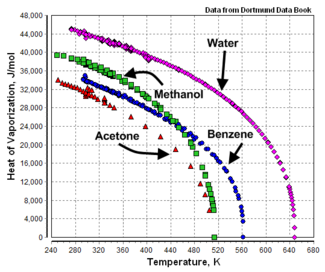User:Milton Beychok/Sandbox
The heat of vaporization, ( or ) is the amount of thermal energy required to convert a quantity of liquid into a vapor. It can be thought of as the energy required to break the intermolecular bonds within the liquid.
It is also often referred to as the latent heat of vaporization ( or ) and the enthalpy of vaporization ( or or ) and is usually measured and reported at the temperature corresponding to the normal boiling point of the liquid. Sometimes reported values have been corrected to a temperature of 298 K.
Measurement units
Heat of vaporization values are usually reported in measurement units such as J/mol or kJ/mol and referred to as the molar heat of vaporization, although J/g or kJ/kg are also often used. Older units such as kcal/mol, cal/g, Btu/lb and others are still used sometimes.
Temperature dependency
The heat of vaporization is not a constant. It is temperature dependent as shown in Figure 1 by the example graphs of temperature versus heat of vaporization for acetone, benzene, methanol and water.
As shown by the example graphs, the heat of vaporization of a liquid at a given temperature (other than the normal boiling point temperature) may vary significantly from the value reported at the normal boiling point of the liquid.
Estimating heat of vaporization values
| ||||||||||||||||||||||||||||||||||||||||||||||||||||||||||||||||||||||||||||||||||||||||||||||||||||||||||||||||||||||||||||||||||||||||||||||||||||||||||||||||||||||||||||||||||
Heats of vaporization can be measured calorimetrically and measured values are available from a number of sources.[1][4][5][6] However, data is not always available for certain liquids or at certain temperatures. In such cases, estimation of heats of vaporization can be made by the three methods (among others) discussed in the following sections.
Using the Clausius-Clapeyron equation
This integrated form of the Clausius-Clapeyron equation can be used to provide a good approximation of the heat of vaporization for many pure liquids:[7][8]
- (1)
which can be re-arranged to obtain:
- (2)
| where: | |
| = Heat of vaporization, in J/mol | |
| = 8.3144 = Universal gas constant, in J/(K mol) | |
| = Logarithm on base | |
| = The liquid's vapor pressure at , in atm | |
| = The liquid's vapor pressure at , in atm | |
| = Temperature, in K | |
| = Temperature, in K |
The primary Clausius-Clapeyron equation is exact. However, the above integrated form of the equation is not exact because it is necessary to make these assumptions in order to perform the integration:[7][8]
- The molar volume of the liquid phase is negligible compared to the molar volume of the vapor phase
- The vapor phase behaves like an ideal gas
- The heat of vaporization is constant over the temperature range as defined by T1 and T2
Using Trouton's rule
Troutons's equation, often referred to as Trouton's rule, also provides good approximations for many pure substances. It may be expressed as:
- (3)
Using Reidel's method
Using Trouton's rule
Using Watson's method
References
- ↑ 1.0 1.1 Dortmund Data Bank Online Search
- ↑ J.M. Smith, H.C. Van Ness and N.M. Abbot (2004). Introduction to Chemical Engineering Thermodynamics, 7th Edition. McGraw-Hill. ISBN 0-07-310445-0.
- ↑ Robert C. Weast (Editor) (1976). Perry's Chemical Engineers' Handbook, 56th Edition. CRC Press. ISBN 0-87819-455-X.
- ↑ Carl L. Yaws (1998). Chemical properties Handbook, 1st Edition. McGraw-Hill. ISBN 0-07--073401-1.
- ↑ Václav Svoboda and Henry V. Kehiaian (1985). Enthalpies of Vaporization of Organic Compounds: A Critical Review and Data Compilation, IUPAC Chemical Data Series 32. Blackwell Scientific. ISBN 0-632-01529-2.
- ↑ Perry, R.H. and Green, D.W. (Editors) (2007). Perry's Chemical Engineers' Handbook, Eighth Edition. McGraw-Hill. ISBN 0-07-142294-3.
- ↑ 7.0 7.1 Jean Vidal (2003). Thermodynamics: Applications in Chemical Engineering and the Petroleum Industry. Editions Technip. ISBN 2-7108-0800-5. (Equation 2.10, page 38)
- ↑ 8.0 8.1 Amir Faghri and Yuwen Zhang (2006). Transport Phenomena in Multiphase Systems, 1st Edition. Academic Press. ISBN 0-12-370610-6. (Equation 2.168, Chapter 2)


















